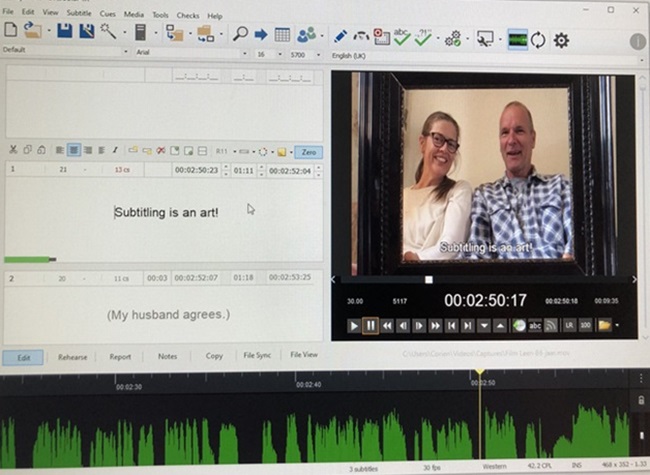
I made my very first subtitle in 1993 and I fell in love on the spot. Subtitle translation is such a wonderful mix of skills! After more than 30 years I still get a kick out of getting it exactly right. And that’s a lot more complicated than you might think…
I wrote my master’s thesis on subtitling, analysing the translation of humorous content in episodes of ‘Monty Python’s Flying Circus’ and ‘The Young Ones’. But even so I had only the faintest grasp of the ins and outs of subtitling before I started working as a subtitle translator. So what are all these skills you need in order to be good at this? Allow me to share the four most important ones.
First of all, you need to be able to condense because subtitles must be short. If you translate everything that’s said in the video, either your whole screen will be covered in words or you’d have to make titles that flash by too fast for viewers to read them. Reading will always be a slower brain process than listening; it’s almost a law of physics. So you condense, and you learn to put in the essence of the meaning.
Condensing sometimes involves tough choices. Here’s an example. A detective arrives at a crime scene and is told by his sergeant: ‘63-year-old male victim, died of multiple stab wounds, time of death approximately 11 o’clock, SOCO will be here in 20 minutes. Coffee?’ That took eight seconds. You could make two four-second subtitles here. That would give you four lines of about 30 characters each. The software indicates how many you can put in to stay within the reading speed. That’s not enough to translate everything, so what do you leave out? You could leave out the coffee because it comes last and all the viewers will hear it clearly, but that might have an annoying effect. You’ll need space to explain what SOCO is. With luck the image will show something useful, perhaps the stab wounds, so you might skip those. You’ll have to find out if the age of the victim is relevant; if not, you might skip that. And so on. If the speech is slow, you’re lucky, but fast speech means lots of condensing without losing the essence in translation.
This need to condense, incidentally, is why I soon learnt not to tell people I’m a subtitler. I got tired of defending my work and explaining the reading speed thing. So at parties, or when meeting old acquaintances, I would avoid the subject of my profession to keep them from going off on the usual tangent: ‘Oh, TV subtitles are awful! They never translate what is said! Even I could do a better job!’ Sure, sure. One time this strategy bit me in the ass because I lied and said I was a pastry cook. Turns out, so was the person I was talking to.
A second skill you need as a subtitle translator – perhaps obviously – is an absolute mastery of the two languages you work with. Having an extensive vocabulary at your fingertips means you can pick the shortest word or phrase for your subtitle translation. You rebuild sentences, cut them into bits to accommodate reading speed, and do it fast because there’s always a deadline!
Third, being able to work with the software because subtitling is quite technical. Learning to work with the software takes time. One second of footage has 25 frames and your job is to time each subtitle to synchronize with the spoken word, down to the frame: 1/25th of a second. The software helps you pinpoint when your subtitle pops up and when it disappears. It also tells you when you put too many characters into a title (so viewers won’t have enough time to read it), or if the line is too long to fit the screen.
When you work for a range of clients, you need to be aware of their different styles. For example, some clients want three-frame intervals between subtitles so the eye will perceive the change. Other clients absolutely forbid subtitles staying on across a shot change. Some allow two speakers in one subtitle with a hyphen to separate them, some don’t. Things like that.
And the fourth skill, while you do all this, is remembering the underlying principle of subtitles: they should be like glasses. They help you watch a movie, but you shouldn’t be aware of them all the time. Subtitles should be unprovocative and so easy to read that you almost forget they’re there.
Studies show that subtitles are a terrific language-learning tool, especially for people whose native tongue is a minority language. In the Netherlands, TV subtitles are more widely read than newspapers. Vast quantities of video material become accessible to the deaf and hard of hearing thanks to subtitling.
Sadly, a lot of subtitle translators need other work on the side, or some other source of income (like rich parents or a partner with a good job) to make ends meet. This is not a well-paid profession. Most video content producers put subtitling way at the bottom of their budgets – often less than 1%. Most viewers will accept shoddy subtitles as a fact of life – they’ll complain, but not to the network or the studio. I was lucky enough to be in permanent employment with a media company for the first 13 years of my subtitling career, but most subtitle translators I know are freelancers. On top of all this, I suspect there will be plenty of AI software and apps in the very near future that will replace human subtitlers.
So there you have it! A fantastic profession, important even, but sadly undervalued. Long may it live.
|
Blog post by: Corinne McCarthy LinkedIn: corinne-mccarthy |
